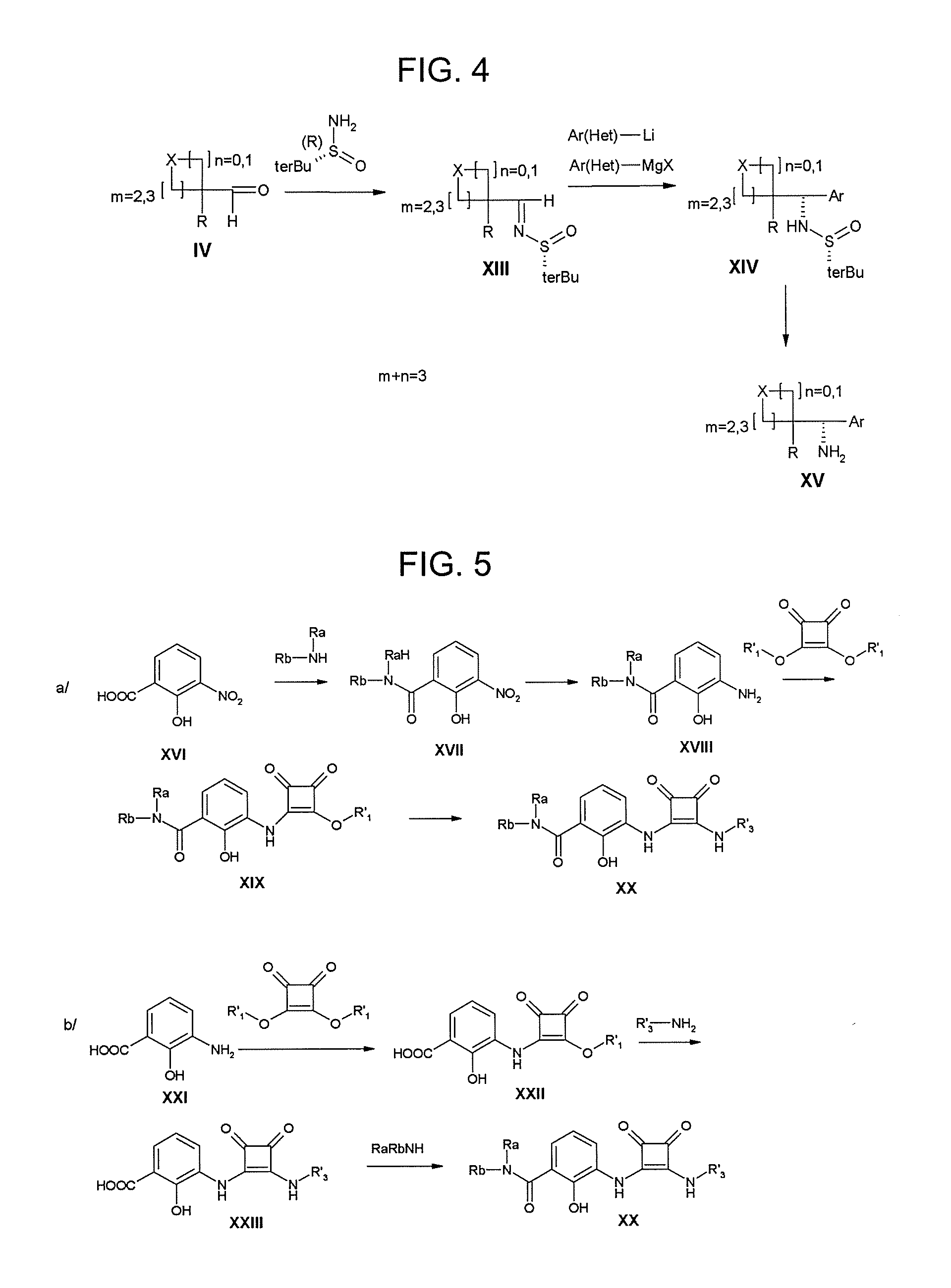Novel disubstituted 3,4-diamino-3-cyclobutene-1,2-dione compounds for use in the treatment of chemokine-mediated diseases
a technology of chemokine-mediated diseases and disubstituted compounds, which is applied in the field of new disubstituted 3, 4diamino3cyclobutene1, 2dione compounds, can solve the problems of insufficient promise of effective new therapies for treating chemokine-mediated diseases using chemokine receptor antagonists, insufficient need, and insufficient clinical studies
- Summary
- Abstract
- Description
- Claims
- Application Information
AI Technical Summary
Benefits of technology
Problems solved by technology
Method used
Image
Examples
example 1
Preparation of 2-hydroxy-N,N-dimethyl-3-(2-{[(5-methylfuran-2-yl)-(2-methyltetrahydrofuran-2-yl)methyl]amino}-3,4-dioxocyclobut-1-enylamino)benzamide
[0095]
Step 1
(2-Methyltetrahydrofuran-2-yl)methanol
[0096]19.94 g (0.145 mol, 1 eq) of 2-methyltetrahydrofuran-2-carboxylic acid (commercial) at 95% in solution in 100 ml of diethyl ether were added dropwise to a suspension, cooled to 10° C., of 16.6 g (0.438 mol, 3 eq) of lithium aluminum hydride in 100 ml of diethyl ether. The reaction medium was stirred at ambient temperature for 24 hours. The reaction medium was cooled and water was added dropwise, followed by a saturated ammonium chloride solution. The medium was extracted with diethyl ether. The organic phases were combined, washed with water, dried over magnesium sulfate, filtered and evaporated. 14.45 g of (2-methyltetrahydrofuran-2-yl)methanol were obtained. Yield=86%. TLC / SiO2: CH2Cl2 / MeOH (95 / 5), developing with KMnO4.
Step 2
2-Methyltetrahydrofuran-2-carbaldhyde
[0097]A solution ...
example 2
Preparation of 2-hydroxy-N,N-dimethyl-3-(2-{[(5-methylfuran-2-yl)-(tetrahydrothiophen-2-yl)methyl]amino}-3,4-dioxocyclobut-1-enylamino)benzamide
[0112]
Step 1
Methoxymethyltetrahydrothiophene-2-carboxylamide
[0113]32.0 ml (0.44 mol; 1.27 eq) of thionyl chloride were added dropwise, at ambient temperature, over the course of 15 minutes, to a solution of 46.0 g (0.35 mol; 1.0 eq) of tetrahydrothiophene-2-carboxylic acid (commercial) in 200 ml of dichloromethane. The reaction medium was stirred at ambient temperature for 3 hours until no more gas was given off. The dichloromethane and the excess thionyl chloride were evaporated off under vacuum and the residue was co-evaporated three times with 100 ml of toluene. The acid chloride obtained was solubilized in 200 ml of dichloromethane, and 37.34 g (0.38 mol; 1.1 eq) of N,O-dimethylhydroxylamine hydrochloride were added. The reaction medium was cooled to −10° C. and a mixture of 116 ml (0.84 mol; 2.4 eq) of triethylamine in 100 ml of dichlor...
example 3
Preparation of methyl (S)-1-[2-fluoro-3-(2-{[(5-methylfuran-2-yl)-(tetrahydrothiophen-2-yl)methyl]amino}-3,4-dioxocyclobut-1-enylamino)benzoyl]pyrrolidine-2-carboxylate
[0131]
Steps 1 to 5
[0132]In a manner analogous to EXAMPLE 2 (steps 1 to 5), C-(5-methylfuran-2-yl)-C-(tetrahydrothiophen-2-yl)methylamine (diastereoisomer 2) was prepared.
Step 6
Methyl (S)-1-(2-fluoro-3-nitrobenzoyl)pyrrolidine-2-carboxylate
[0133]A mixture of 18.51 g (0.10 mol; 1.0 eq) of 2-fluoro-3-nitrobenzoic acid and 100 ml of thionyl chloride was refluxed for 3 hours. The excess thionyl chloride was then concentrated and the residue was co-evaporated twice with toluene. The resulting acid chloride was taken up in 250 ml of dichloromethane. To this mixture, cooled to 0° C., were added 16.56 g (0.10 mol; 1.0 eq) of L-proline methyl ester hydrochloride and then 30.50 ml (0.22 mol; 2.2 eq) of triethylamine. After 30 minutes at 0° C. and one hour at ambient temperature, the reaction medium was diluted and washed with 25...
PUM
| Property | Measurement | Unit |
|---|---|---|
| Composition | aaaaa | aaaaa |
Abstract
Description
Claims
Application Information
 Login to View More
Login to View More - R&D
- Intellectual Property
- Life Sciences
- Materials
- Tech Scout
- Unparalleled Data Quality
- Higher Quality Content
- 60% Fewer Hallucinations
Browse by: Latest US Patents, China's latest patents, Technical Efficacy Thesaurus, Application Domain, Technology Topic, Popular Technical Reports.
© 2025 PatSnap. All rights reserved.Legal|Privacy policy|Modern Slavery Act Transparency Statement|Sitemap|About US| Contact US: help@patsnap.com



